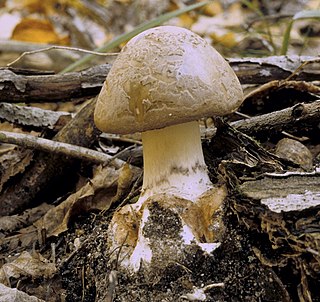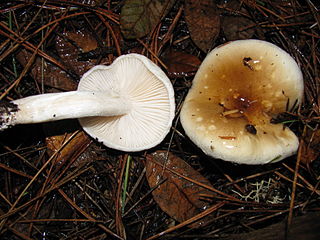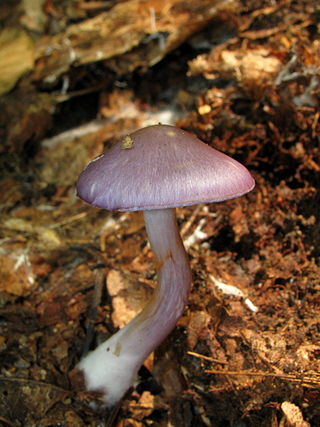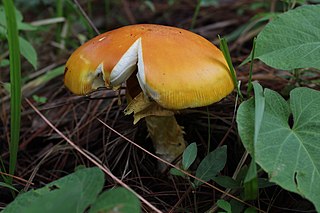
Amanita gemmata, commonly known as the gemmed amanita or the jonquil amanita, is an agaric mushroom of the family Amanitaceae and genus Amanita. The fruit body has a cap that is a dull to golden shade of yellow, and typically 2.5–12 centimetres in diameter. The cap surface is sticky when moist, and characterized by white warts, which are easily detached. It is initially convex, and flattens out when mature. The flesh is white and does not change colour when cut. The gills are white and closely spaced. The stem is pale yellow, and measures 4–12 cm long by 0.5–1.9 cm thick. The partial veil that covers the young fruit body turns into the ring on the stem at maturity. The spore print is white. It resembles numerous other species.

Amanita brunnescens, also known as the brown American star-footed amanita or cleft-footed amanita is a native North American mushroom of the large genus Amanita. It differs from A. phalloides by its fragile volva and tendency to bruise brown.

Amanita persicina, commonly known as the peach-colored fly agaric, is a basidiomycete fungus of the genus Amanita with a peach-colored center. Until c. 2015, the fungus was believed to be a variety of A. muscaria.

Hygrophorus agathosmus, commonly known as the gray almond waxy cap or the almond woodwax, is a species of fungus in the family Hygrophoraceae. It was first described by Elias Magnus Fries in 1815; Fries gave it its current name in 1838. A widespread species, it is distributed in the United States, Europe, Africa, and India, and is found growing under spruce and pine in mixed forests. The fruit bodies are characterized by a light grayish cap that measures up to 8 cm (3.1 in) in diameter, waxy gills, a dry stem, and the distinct odor of bitter almonds. An edible but bland-tasting mushroom, extracts of the fruit bodies have been shown in laboratory tests to have antimicrobial activity against various bacteria that are pathogenic to humans.

Lactarius subflammeus, commonly known as the orange milk cap, is a species of fungus in the family Russulaceae. It is found in western North America in the late summer and fall and is especially common in the Pacific Northwest, where it grows on the ground near conifers like pine and spruce. The brightly colored fruit bodies, which are slimy or sticky, have scarlet caps when young that soon fade to brilliant orange. The stem—typically longer than the width of the cap—is also bright orange but the gills are whitish. The mushroom secretes a whitish latex when it is cut or injured.

Lactarius aspideus, commonly known as the bright yellow milkcap, is a species of fungus in the family Russulaceae. Distinctive characteristics of the fruit body include the sticky, pale yellow cap, and the abundant latex that stains the mushroom tissue lilac. It is found in North America.

Lactarius alnicola, commonly known as the golden milkcap, is a species of fungus in the family Russulaceae. The fruit bodies produced by the fungus are characterized by a sticky, vanilla-colored cap up to 20 cm (7.9 in) wide with a mixture of yellow tones arranged in faint concentric bands. The stem is up to 5 cm (2.0 in) long and has yellow-brown spots. When it is cut or injured, the mushroom oozes a white latex, which has an intensely peppery taste. The acrid taste of the fruit bodies renders them unpalatable. The fungus is found in the western United States and Mexico, where it grows in mycorrhizal associations with various coniferous trees species, such as spruce, pine and fir, and deciduous species such as oak and alder. It has also been collected in India. Two varieties have been named: var. pitkinensis, known from Colorado, and var. pungens, from Michigan.

Lactarius affinis, commonly known as the kindred milk cap, is a species of milk-cap mushroom in the family Russulaceae. It is found northeastern North America, where it fruits in the summer and fall, and is common in the Great Lakes region. Its fruit bodies have medium to large, slimy dull yellow or brownish caps. Although not considered poisonous, it is unpalatable because of its highly acrid taste.

Lactarius argillaceifolius is a species of fungus in the family Russulaceae. The mushrooms produced by the fungus have convex to flattened drab lilac-colored caps that are up to 18 cm (7.1 in) wide. The cream-colored gills are closely spaced together and extend slightly down the length of the stem, which is up to 9 cm (3.5 in) long by 3.5 cm (1.4 in) thick. The mushroom produces an off-white latex when injured that stains the mushroom tissue brownish.

Cortinarius varius, also known as the contrary webcap, is a basidiomycete mushroom of the genus Cortinarius. The mushroom has orangish-yellow caps that reach up to 10 cm (3.9 in) in diameter, and thick club-shaped stems up to 10 cm (3.9 in) long.

Cortinarius traganus, also known as the gassy webcap or lilac conifer cortinarius, is a basidiomycete mushroom of the genus Cortinarius. The mushrooms are characterized by their lilac color, the rusty-brown gills and spores, and rusty-brown flesh in the stem.

Cortinarius delibutus, also known as the bluegill webcap or the yellow webcap, is a basidiomycete fungus of the genus Cortinarius. The fruit bodies are medium-sized, with shiny yellow caps on a sticky, yellow-banded club-shaped stem. The mushroom is found in Europe and North America, usually near birch or beech trees.

Hygrophorus eburneus, commonly known as the ivory waxy cap or the cowboy's handkerchief, is a species of edible mushroom in the waxgill family of fungi. It is widespread in Europe and North America, and has also been collected in northern Africa. The fruit bodies are medium-sized, pure white, and when wet are covered in a layer of slime thick enough to make the mushroom difficult to pick up. The gills are broadly attached to the stem or running down it; as the family name suggests, they feel waxy when rubbed between the fingers. Like all Hygrophorus species, the fungus is mycorrhizal—a symbiotic association whereby the underground fungal mycelia penetrate and exchange nutrients with tree roots. They are common in a variety of forest types, where they grow on the ground in thickets or grassy areas. Hygrophorus eburneus is the type species of the genus Hygrophorus. A number of biologically active chemicals have been purified from the fruit bodies of the fungus, including fatty acids with bactericidal and fungicidal activity.

Hygrophorus bakerensis, commonly known as the Mt. Baker waxy cap, the brown almond waxy cap or the tawny almond waxy cap, is a species of fungus in the family Hygrophoraceae. It is characterized by its medium to large, relatively slender-statured fruit bodies with an almond odor, and growth often on or near rotting conifer wood. The slimy cap is brown in the center and cream to white near its curved edges. The gills and the stem are white, and in moist environments are often covered with droplets of a translucent liquid. The mushroom is known only from the United States, where it is common in coniferous forests throughout the Pacific Northwest. It was initially collected in Washington State on Mount Baker, a volcano. Although edible, the mushroom is not considered to be of high quality.

Amanita albocreata, also called the ringless panther or the ringless panther amanita, is a species of fungus in the family Amanitaceae. It was discovered in 1944, by William Murrill. It is commonly found in the northeastern United States and parts of southeastern Canada. It normally grows between the rainy months of June and August.

Hygrophorus olivaceoalbus, commonly known as the olive wax cap or sheathed waxy cap, is a species of fungus in the genus Hygrophorus. The fruit bodies (mushrooms) appear from midsummer to late autumn under conifers in North American and Eurasian mountain forests. The mushrooms have olive-brown, slimy caps with dark streaks and a dark umbo; the caps measure 3 to 12 cm in diameter. Other characteristic features include a slimy stem up to 12 cm long that is spotted with ragged scales up to a ring-like zone. As its name implies, the mushroom has a waxy cap and gills. It is native to North America and across the northern regions of Europe. According to a publication by the Council of Europe, the fungus is nearly extinct in France.
Amanita zambiana, commonly known as the Zambian slender Caesar, is a basidiomycete fungus in the genus Amanita. An edible mushroom, it is found in Africa, where it is commonly sold in markets.

Cortinarius iodes, commonly known as the spotted cort or the viscid violet cort, is a species of agaric fungus in the family Cortinariaceae. The fruit bodies have small, slimy, purple caps up to 6 cm (2.4 in) in diameter that develop yellowish spots and streaks in maturity. The gill color changes from violet to rusty or grayish brown as the mushroom matures. The species range includes eastern North America, Central America, northern South America, and northern Asia, where it grows on the ground in a mycorrhizal association with deciduous trees. The mushroom is not recommended for consumption. Cortinarius iodeoides, one of several potential lookalike species, can be distinguished from C. iodes by its bitter-tasting cap cuticle.

Amanita basii is a mushroom of the family Amanitaceae.

Zhuliangomyces illinitus is a mushroom-forming fungus species of genus Zhuliangomyces in the family Amanitaceae in the order Agaricales. It has been known most recently as Limacella illinita. Also known previously as Agaricus illinitus and Mastocephalus illinitus. This fungus is known for its distinctive slimy cap. Z. illinitus is commonly known as the dripping slimecap or the overflowing slimy stem.




















